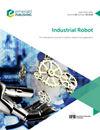基于强化学习的冗余机械手可操纵性优化
IF 2.5
4区 计算机科学
Q3 ENGINEERING, INDUSTRIAL
Industrial Robot-The International Journal of Robotics Research and Application
Pub Date : 2023-07-05
DOI:10.1108/ir-01-2023-0002
引用次数: 0
摘要
目的利用无模型强化学习(RL)算法优化可操作性,克服了矩阵反演、公式变换复杂、计算时间昂贵等难题。可操纵性优化是解决机械手控制中奇异性问题的有效途径。为了优化轨迹跟踪过程中的可操纵性,提出了一些控制方案,但存在矩阵反演、公式变换复杂、计算时间昂贵等问题。结果:通过RL训练的冗余机械手能够实时调整构型,在跟踪期望轨迹的同时实现无逆操纵性优化。计算机仿真和物理实验表明,与现有方法相比,该方法的平均可操纵性提高了58.9%,计算时间缩短到17.9%。因此,该方法有效地优化了可操纵性,大大缩短了计算时间。原创性/价值据作者所知,这是在轨迹跟踪过程中使用强化学习优化可操控性的第一种方法。将该方法与现有的奇点避免和可操纵性最大化方法进行了比较,证明了该方法具有更好的优化效果和更少的计算时间。本文章由计算机程序翻译,如有差异,请以英文原文为准。
Manipulability optimization of redundant manipulators using reinforcement learning
Purpose
The purpose of this paper is using a model-free reinforcement learning (RL) algorithm to optimize manipulability which can overcome difficulties of dilemmas of matrix inversion, complicated formula transformation and expensive calculation time.
Design/methodology/approach
Manipulability optimization is an effective way to solve the singularity problem arising in manipulator control. Some control schemes are proposed to optimize the manipulability during trajectory tracking, but they involve the dilemmas of matrix inversion, complicated formula transformation and expensive calculation time.
Findings
The redundant manipulator trained by RL can adjust its configuration in real-time to optimize the manipulability in an inverse-free manner while tracking the desired trajectory. Computer simulations and physics experiments demonstrate that compared with the existing methods, the average manipulability is increased by 58.9%, and the calculation time is reduced to 17.9%. Therefore, the proposed method effectively optimizes the manipulability, and the calculation time is significantly shortened.
Originality/value
To the best of the authors’ knowledge, this is the first method to optimize manipulability using RL during trajectory tracking. The authors compare their approach to existing singularity avoidance and manipulability maximization techniques, and prove that their method has better optimization effects and less computing time.
求助全文
通过发布文献求助,成功后即可免费获取论文全文。
去求助
来源期刊
CiteScore
4.50
自引率
16.70%
发文量
86
审稿时长
5.7 months
期刊介绍:
Industrial Robot publishes peer reviewed research articles, technology reviews and specially commissioned case studies. Each issue includes high quality content covering all aspects of robotic technology, and reflecting the most interesting and strategically important research and development activities from around the world.
The journal’s policy of not publishing work that has only been tested in simulation means that only the very best and most practical research articles are included. This ensures that the material that is published has real relevance and value for commercial manufacturing and research organizations. Industrial Robot''s coverage includes, but is not restricted to:
Automatic assembly
Flexible manufacturing
Programming optimisation
Simulation and offline programming
Service robots
Autonomous robots
Swarm intelligence
Humanoid robots
Prosthetics and exoskeletons
Machine intelligence
Military robots
Underwater and aerial robots
Cooperative robots
Flexible grippers and tactile sensing
Robot vision
Teleoperation
Mobile robots
Search and rescue robots
Robot welding
Collision avoidance
Robotic machining
Surgical robots
Call for Papers 2020
AI for Autonomous Unmanned Systems
Agricultural Robot
Brain-Computer Interfaces for Human-Robot Interaction
Cooperative Robots
Robots for Environmental Monitoring
Rehabilitation Robots
Wearable Robotics/Exoskeletons.

 求助内容:
求助内容: 应助结果提醒方式:
应助结果提醒方式:


